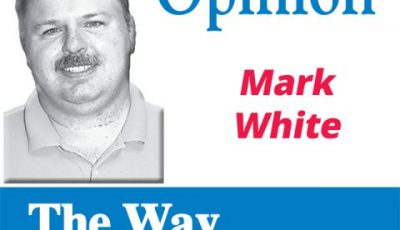After an enjoyable trip, allow me to catch up with a few thoughts
Did I ever pick a good time to leave Kentucky and go on vacation, or what? COVID-19 rates have pretty well skyrocketed recently in Whitley County.

Mark White is Editor of The News Journal.
My wife, Cecelia, and I recently headed south to the Outer Banks in North Carolina for a week, then we headed over to the Maryland-Delaware border where we checked out two islands with a lighthouse and a nature preserve.
As an added bonus, we got to watch the Atlas rocket launch Friday night from behind our hotel, which was sending a payload to the International Space Station.
So, what does a guy, who takes pictures for his job, do while he is on vacation? I got up before the crack of dawn most days running around taking a lot of pictures. I know. I need to diversify my interests…LOL.
Don’t worry. We tried to stay safe, Lysol wiping pretty much every contact surface in our hotel rooms after we checked in. We also wore masks when we went inside buildings, or went to places where we couldn’t socially distance. Much of our time was spent outdoors.
It was a fun trip with some much needed rest.
Now to touch on some recent local topics before I conclude this column.
• Kudos to the Whitley County School District, which recently received a $356,651 grant from the U.S. Department of Justice Community Oriented Policing Services (COPS) School Violence Prevention Program.
The money will be used to equip entry doors at schools with digital card readers granting access to the buildings to only those with credentials. The grant will also provide for some upgraded security cameras and vape detecting sensors that will be placed strategically in several areas of schools.
• Some local school districts have already returned to in-person classes, and others, like Whitley County and Williamsburg, are hoping to soon do so once Whitley County COVID-19 rates decrease.
Once in-person classes resume, it isn’t a matter of if some students and staff members will get infected with COVID-19, but when. The Laurel County School District returned to in-person classes in early September, and as of Monday had already reported 31 total COVID-19 cases and 12 staff cases. All but two of these cases are active, according to the state’s official website.
I don’t worry so much about first and second graders getting COVID-19 and recovering from it. Kids of that age are pretty resilient. Much more so than we adults.
What concerns me most about COVID-19 in the schools is actually our teenagers who vape. Like cigarette smoking, vaping certainly isn’t good for your lungs to say the least, and this is if you are just vaping nicotine and not something worse. When you add this risk factor to a case of COVID-19, which can be a serious respiratory illness, things could get really bad for some students.
For those, who think that we don’t have a vaping problem among teenagers, I would point out that Whitley County School District is using part of its grant funds to purchase vaping sensors for schools. You don’t do this if there isn’t a problem, and Whitley County certainly isn’t alone in dealing with vaping cases.
I don’t mention this to pick on Whitley County, but to illustrate a point. I wrote a story a couple of years back detailing the vaping problem among our teenage population, and every local high school has dealt with it.
• The Kentucky Supreme Court recently ruled against the use of “historical racing machines” at race tracks, which opponents have basically described as glorified slot machines.
I just hope this doesn’t kill the proposed Keeneland and Kentucky Downs horse racing track proposed for Corbin, which was expected to include several “historical racing machines,” in addition to a 22,000 square-foot facility in Williamsburg that would include about 400 “historical racing machines,” simulcast wagering, a hotel and restaurants.
As I said, I am hoping this doesn’t impact those proposed facilities, but I can’t say that I am optimistic that it won’t. Given that the Corbin track would only run races a few weeks a year, it is likely that Keeneland and Kentucky Downs were counting on income from the “historical racing machines” in order to make these projects profitable.





